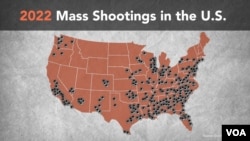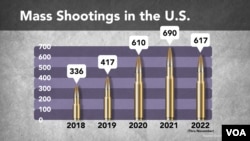Across America, gun violence surged in many communities in 2022 as overall death rates from firearms rose to the highest level in nearly three decades. The year saw a near-record number of mass casualty shooting incidents, including several allegedly motivated by hate.
“For God’s sake, how much more carnage are we willing to accept? How many more innocent American lives must be taken before we say enough is enough?” asked U.S. President Joe Biden in a nationally televised address in May — days after the deadliest U.S. school shooting incident in nearly a decade.
Biden joined the nation in mourning after an 18-year-old gunman wielding a semi-automatic rifle killed 19 children and two adults at Robb Elementary School in Uvalde, Texas.
The attacker, a former student at the school, fired hundreds of rounds as he carried out the massacre. Heavily armed law enforcement officers delayed storming the building for approximately an hour, sparking outrage from the community and across the nation.
The young lives taken illustrate a sobering statistic that guns are now the number one killer of children in the United States, according to the Centers for Disease Control and Prevention.
The tragedy came less than a month after another a 19-year-old — also armed with a semi-automatic rifle — opened fire at a supermarket in Buffalo, New York, killing 10 people. The suspect said he was targeting Black people.
In November, a mass shooting at a Colorado Springs gay nightclub claimed five lives and left 17 others wounded. The 22-year-old suspect was charged with murder and bias-motivated crimes.
“We are seeing a return to much higher rates of gun violence than we have seen for a long time,” said Jack McDevitt, a professor at Northeastern University School of Criminology and Criminal Justice in Boston, Massachusetts, speaking with VOA. “We are starting to see more people use firearms to go after victims who they perceive to be different.”
Analysts believe guns, especially semiautomatic handguns and rifles, are being used more often to settle disputes and in crimes motivated by hate.
Investigators are looking into the possibility that antisemitism was the motivation for a gunman who killed seven people and wounded dozens of others gathered for a July 4 Independence Day parade in Highland Park, Illinois. From atop a building, the suspect fired 83 rounds in less than a minute.
“Our sense of security is permanently ruptured,” said Dr. Emily Lieberman, a pediatrician who witnessed the shooting with her children. She and a group of fellow doctors traveled to Washington in December to urge lawmakers to pass a ban on assault weapons.
“As mass shootings continue to rise year after year, I realize that complacency is just as dangerous as these attacks themselves.," she said. "The time is now to save lives.”
Mass shootings rise
The U.S. experienced more than 600 mass shootings in 2022, nearly double the number recorded four years ago when there were 336, according to Washington-based Gun Violence Archive.
Mass shootings are broadly defined as an incident in which four or more people are shot or killed, not including the shooter.
Analysts see a link between bias-motivated gun violence and a rise in hate groups and toxic discourse in the United States targeting vulnerable, often marginalized populations.
“One of the problems with seeing gun violence in the context of hate crimes is that the trauma isn’t just to the individual; the trauma is to that community,” said Professor Carlos Cuevas, co-director of the Center on Crime, Race and Justice at Northeastern University. “It is a crime against a person but it is also a crime against a group.”
While mass shootings grab news headlines, they account for a small percentage of the more than 40,000 U.S. gun deaths recorded in 2022. Half were by suicide, according to Gun Violence Archive.
“One of the positive things in all of this is that mass shooting events are the most visible but the least frequently occurring ones,” Cuevas noted. “It’s important to provide continuing support to communities and help them recover a sense of safety that will help them heal from these events going forward.”
Debate over gun laws
In June, Congress approved the first national gun legislation in decades. The law seeks to deny firearms to those deemed dangerous and a threat to public safety. It would also fund new mental health programs and require enhanced background checks on gun buyers aged 18 to 21.
Many Republican lawmakers opposed the legislation. “Democrats are coming after law-abiding American citizens’ Second Amendment liberties,” said Ohio Republican Congressman Jim Jordan, referring to the constitutional right to “keep and bear arms” that gun rights defenders believe should be broadly protected.
But many Democrats and gun control advocates want to go further and ban semi-automatic weapons, among other restrictions.
“Now the moral imperative is to act against ghost guns [untraceable firearms often bought online], against assault weapons, against high-capacity magazines, against a system that allows people to keep guns when they say they are going to kill themselves and others,” said Connecticut Democratic Senator Richard Blumenthal in December.
Georgia resident Henderson Masiyakurima said his perspective on gun legislation changed after his best friend was shot to death in 2017. “My thought on weapons and guns was like, “Oh, I’m defending myself,” he said in an interview with the Reuters news agency. “Lately it just looks like, it’s just, been going crazy with a lot of this gun violence. It’s time for a change.”
While many gun rights advocates bemoaned the law passed by Congress, they cheered a U.S. Supreme Court decision striking down a New York state law that restricted the carrying of concealed handguns in public.
“They are lawful citizens that have the right to bear arms. And they also have the right, now the Supreme Court has said it, to bear arms outside the home and protect themselves,” said Tiffany Cheuvront, an attorney for the California Rifle and Pistol Association.
Following the ruling, some Democrat-led states moved to enhance gun laws while Republican-led states sought to challenge or eliminate existing gun restrictions.
Gun availability
The changing legal landscape for firearms comes as gun ownership continues to grow in the United States.
American gunmakers churned out more than 11 million firearms in 2020, nearly three times the number manufactured in 2000, according to a report by the U.S. Bureau of Alcohol, Tobacco, Firearms and Explosives. A survey by the nonpartisan Small Arms Survey estimated the U.S. had about 400 million firearms in 2018, more guns than the country’s population.
As the number of firearms grows, the United States remains plagued by the highest rate of gun deaths among advanced industrialized nations.
“It looked like we were moving the needle pretty well in terms of reducing gun violence, but we have seen it come back with a vengeance over the past three or four years,” said criminologist McDevitt. “The reality is we should be comparing ourselves to other countries where it’s hard to get guns, like Britain and Japan, where gun violence rates are 10 times less than in some of the safest U.S. states.”












